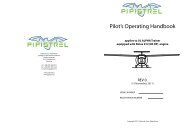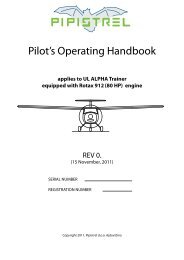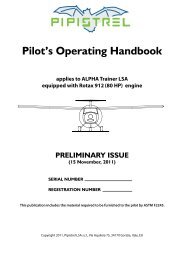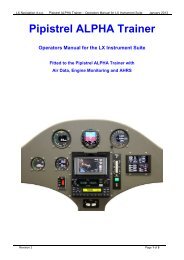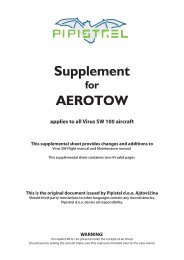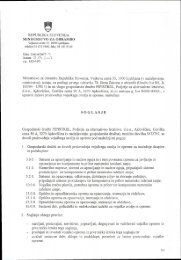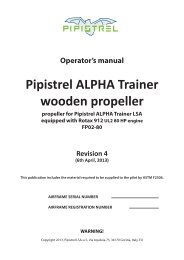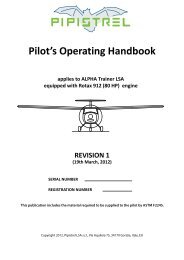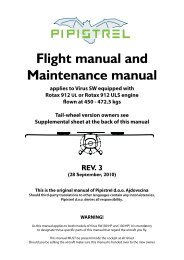Taurus ELECTRO manual 472 ENG.pdf - Pipistrel
Taurus ELECTRO manual 472 ENG.pdf - Pipistrel
Taurus ELECTRO manual 472 ENG.pdf - Pipistrel
Create successful ePaper yourself
Turn your PDF publications into a flip-book with our unique Google optimized e-Paper software.
54 TAURUS <strong>ELECTRO</strong> www.pipistrel.si<br />
REV. 0 Weight and balance<br />
Introduction<br />
This section contains the payload range within which the aircraft may be safely operated.<br />
Weighing procedure and procedure for calculating the in-flight c.g. are also provided.<br />
Refer to equipment list for the installed equipment and accessories.<br />
Weighing and c.g. calculation - empty mass<br />
1. Completely assemble the aircraft, in closed space without any wind disturbance, and with:<br />
- gear down<br />
- motor, flaps and airbrakes retracted,<br />
- control surfaces neutral,<br />
- equipment and accessories in accordance with equipment list.<br />
2. Remove all foreign objects, e.g. tools, maps, ...<br />
3. Empty the water ballast tank, remove baggage.<br />
4. Insert scales under main and a scale with support under tail wheel in order to level the<br />
airplane as follows:<br />
- the slope of upper and lower contour of fuselage tailcone in front of fin must be equal, check<br />
with water scale,<br />
- wings level.<br />
5. Read scale readings, subtract eventual tare weight in order to get net weight.<br />
NOTE: If accurate high range scales for main wheels are not available, aircraft<br />
empty mass may bedetermined by adding up masses of all componets: lefthand<br />
wing, right-hand wing, fuselage, horizontal tail.<br />
6. Measure distances »a« and »b« between verticals through axis of main wheels, tail wheel<br />
and datum.<br />
Use plumb line to mark verticals at the floor.<br />
For main wheels and wing leading edges take average of Left-hand and Right-hand verticals.<br />
Note: Distances »a« and »b« may change with aircraft weight due to deflection<br />
of landing gear - they must be measured at each weighing.<br />
7. Calculate c.g. of empty mass as follows:<br />
X CG.empty<br />
= (G 2<br />
.b) / G empty<br />
- a<br />
G [kg] Empty mass (with equipment and accessories in accordance with equipment<br />
empty<br />
list, but without occupant(s), baggage and water ballast).<br />
G 2<br />
[kg] Load on tailwheel.<br />
X CG.empty<br />
[mm] Location of empty mass c.g., positive aft of datum.<br />
a [mm] Distance between main wheel axis and datum, positive for main wheel forward<br />
of datum.<br />
b [mm] Distance between main and tail wheel axis, always positive.<br />
Datum Leading edge of wing root section..





